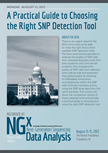CONFERENCE SERIES: Technology & Tools for Life Sciences
Recorded at: NGX: Applying Next-Generation Sequencing

 About this Product:
About this Product:
There is an urgent need for the NGS community to be able to make the right choice from available SNP detection tools. We have used exome-seq data to evaluate the quality of SNP calls from selected discovery tools from both academic and commercial products. We compared the quality of SNP calls from selected tools side by side and assessed their global quality by checking for Mendelian inheritance inconsistencies within the SNP calls of family members and by using the SNP array data from the same samples. This course will show the comparison results of these selected tools and provide a practical guide to choosing and using the right SNP detection tool.
About this Product:
2 Presentations
156 slides
Over 141 minutes
Agenda At A Glance:
 Part 1: Comparison Study of NGS SNP Detection Tools
Part 1: Comparison Study of NGS SNP Detection Tools
Ming Yi, Ph.D., IT Manager, Functional Genomics/Bioinformatics Support Group, Advanced Biomedical Computing Center, SAIC-Frederick, FNLCR
- Brief background and introduction for the current status of SNP detection field and each of the selected tools to be compared
- Description of our benchmark exome-seq data with pedigree info and SNP array data from matched-samples and why they are useful for comparison of these tools for SNP call quality
- Comparison and validation results of these tools using the benchmark data
- Conclusion and take-home message
- Q & A session
Part 2: Detailed Illustration of the Practical Usage of Each SNP Detection Tool
Ming Yi, Ph.D., IT Manager, Functional Genomics/Bioinformatics Support Group, Advanced Biomedical Computing Center, SAIC-Frederick, FNLCR
- Brief introduction of practical aspects of the tools (e.g., download, installation, interface, running environment, basic system requirement etc)
- Practical command lines for command-driven tool(s), parameter options, wrapper script examples for the command-driven tools, interface for commercial tools
- Brief discussion of result files and some diagnosis plots, etc.
- Q & A session
Biography: Currently, as the manager of Functional Genomic Group of ABCC Bioinformatics Support Group in SAIC-Frederick at Frederick National Laboratory for Cancer Research (formerly National Cancer Institute (NCI) at Frederick), Dr. Yi is leading the group effort for bioinformatics support with focus on NGS, microarray and other high-throughput data analysis, and pathway analysis for NCI researchers. After joining ABCC in 2004, he developed WPS pathway analysis package, on top of which he added two novel pathway-level analysis schemes; SLEPR and PPEP, He has numerous publications on these pathway analysis modules and contribute chapters on pathway analysis in several bioinformatics books including “Statistics and Informatics in Molecular Cancer Research”, and “Insertional Mutagenesis Strategies in Cancer Genetics”. His current focus is leading the efforts to set up and evaluate NGS data analysis pipelines in ABCC especially on SNP discovery tools. He is also interested in association/linkage analysis tools, SNP impact assessment in combination of integrative pathway analysis tools.
About the Conference:
Sequencing a genome is only the beginning. Several layers of analysis are necessary to convert raw sequence data into understanding of functional biology. First, error sources in the original raw data from multiple platforms and diverse applications must be accounted for. Then, as computational methods for assembly, alignment, and variation detection continue to advance, a broad range of genetic analysis applications including comparative genomics, high-throughput polymorphism detection, analysis of coding and non-coding RNAs, and identifying mutant genes in disease pathways can be addressed. CHI’s Next-Generation Sequencing Data Analysis conference combines unique perspectives from a variety of researchers, engineers, biostatisticians, and software developers involved in NGS data analysis.